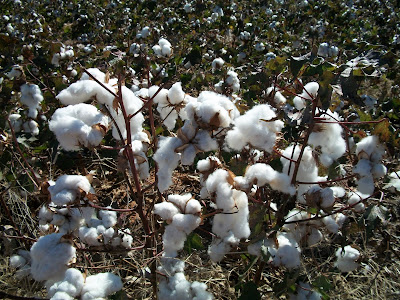The History of Cotton in Oklahoma information provided by OSU Extension Service via the internet. OSU Extension Service provides more information and so many learning opportunities across the state. If you have never been to the extention service office in your county you should stop in and check out the free brochures and other educational materials they offer. If you live in another state check to see where your extension service office is located.
I found this field of cotton right along Interstate 40 in Custer County, Oklahoma. I only caught my shirt twice on the barbed wire fence trying to get close enough to get these photos.
Amazing how they pop open and there is the cotton.
During the years after the land runs of 1889 and later, farmers in Oklahoma were just learning what would grow well in the new territory. During the 1890s, Oklahoma Agricultural Experiment Station bulletins featured research on such subjects as wheat, fruits, potatoes, cabbage--even wine making. In 1895, George L. Holter published research entitled "Food Value of Corn Scorched by Hot Winds." However, by the early part of the century, researchers were beginning to look at cotton as a valuable crop for Oklahoma. In 1908, the Oklahoma Agricultural Experiment Station, at Oklahoma A&M College (now Oklahoma State University), published Bulletin No. 77, "Cotton Culture." The authors, L. A. Moorhouse and J. F. Nicholson, concluded:
Cotton is a banner crop in Oklahoma. This crop has been tested for several years in succession in the two territories, and the practical grower has reached the conclusion that cotton can be cultivated with profit in the new state.
(NOTE: In my research about my husband's hometown Ardmore, Oklahoma in Carter County, I found information that said Carter County was the largest inland cotton market in the world in 1890's!)
By 1922, cotton was the most valuable cash crop in Oklahoma. In fact, in that year Oklahoma ranked fourth among the cotton-producing states, and the Experiment Station had been doing cotton variety tests for several years. In 1928, Oklahoma A&M cotton specialist L. L. Ligon published his report on "Varieties of Cotton for Oklahoma."
Today, cotton is still an important cash crop for Oklahoma's farmers. During the 1990s cotton has consistently ranked within the top three or four cash crops for the state, behind winter wheat, hay, and at times, peanuts. The year 1996, with unusually good corn and sorghum crops, was an exception. The value of the cotton crop for that year put it in sixth place. Nationally, Oklahoma ranks 14th in production of cotton.
Most of Oklahoma's cotton is grown in the southwestern part of the state, although cotton can be grown as far north as Kay County, bordering Kansas. Wheat and cattle may be the dominant agricultural commodities in Oklahoma today, but cotton, which has played a significant role in the state's agricultural history, continues to be one of Oklahoma's most valuable crops.
--------------------------------------------------------------------------------
OCES Cotton IPM Oklahoma Cooperative Extension Service
Division of Agricultural Sciences and Natural Resources
Oklahoma State University
THANK YOU OSU EXTENSION SERVICE FOR THE HISTORY OF COTTON IN OKLAHOMA.
 |
| COTTON AS FAR AS I COULD SEE THANK YOU FARMERS FOR GROWING SO MANY THINGS WE USE IN OUR EVERYDAY LIVES! |



No comments:
Post a Comment